Review Article: Agro Morphological Trait Evaluation of Garlic (Allium Sativum L.) Response to Fertilizer
DOI:
https://doi.org/10.14738/tnc.111.14079Keywords:
Diversity, Morphological traits, Growth, Yield, Fertilizer and NitrogenAbstract
As a review, garlic (Allium sativum L.) is one of the main allium vegetable crops known through worldwide with respect to its production and economic value. Garlic belongs to the genus Allium and family Alliaceous. Garlic has high morphological diversity and adaptable to different agro-climatic regions and environments. Morphological and agronomic variations in characteristics of garlic are shown such as color of the bulb, size of the bulb, plant height, number of cloves, size of the cloves, days to harvesting, resistance to storage capacity, dormancy and adaptation to agro-climatic conditions. Farmers endeavor to produce high yield and good quality garlic for consumption and economic value. Correlation between some quantitative traits of garlic showed the positive and significant correlation with yield and leaf length. All yield and yield-related traits were significantly influenced through the interaction of cultivar and nitrogen fertilizer except leaf length, leaf number per plant, bulb length and sizes of bulbs and cloves of different categories that were significantly influenced either by both cultivar and nitrogen or one of these.
Downloads
Published
How to Cite
Issue
Section
License
Copyright (c) 2023 Bekele Kindie, Solomon Mengistu

This work is licensed under a Creative Commons Attribution 4.0 International License.






